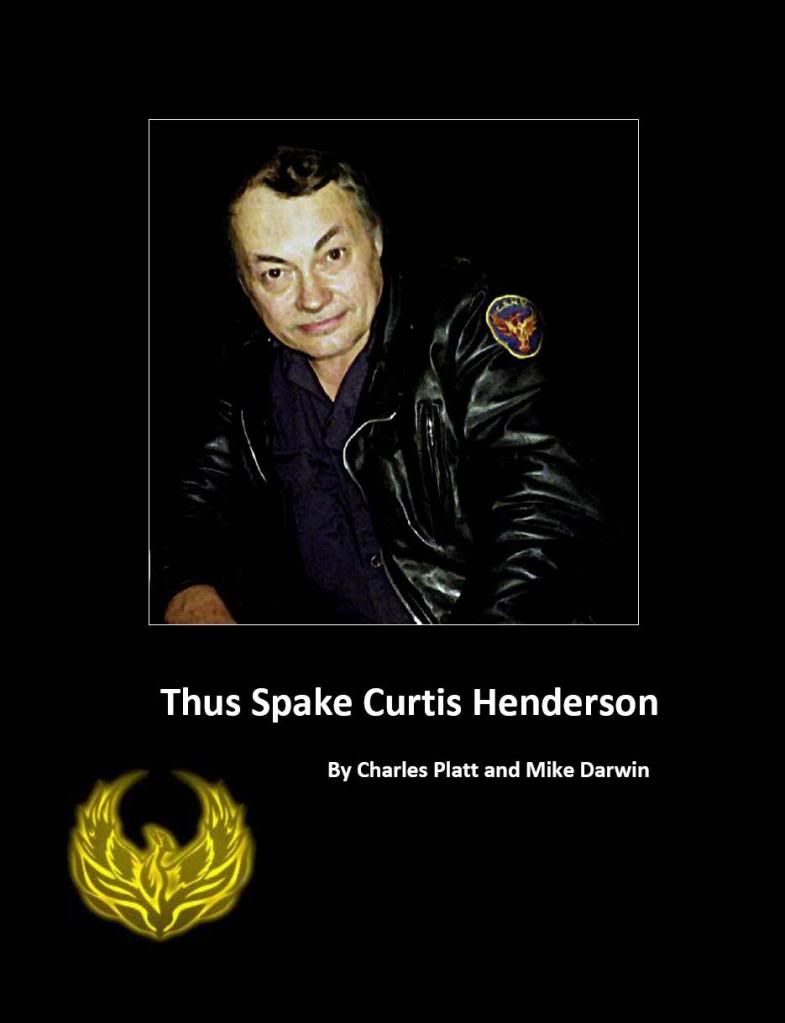
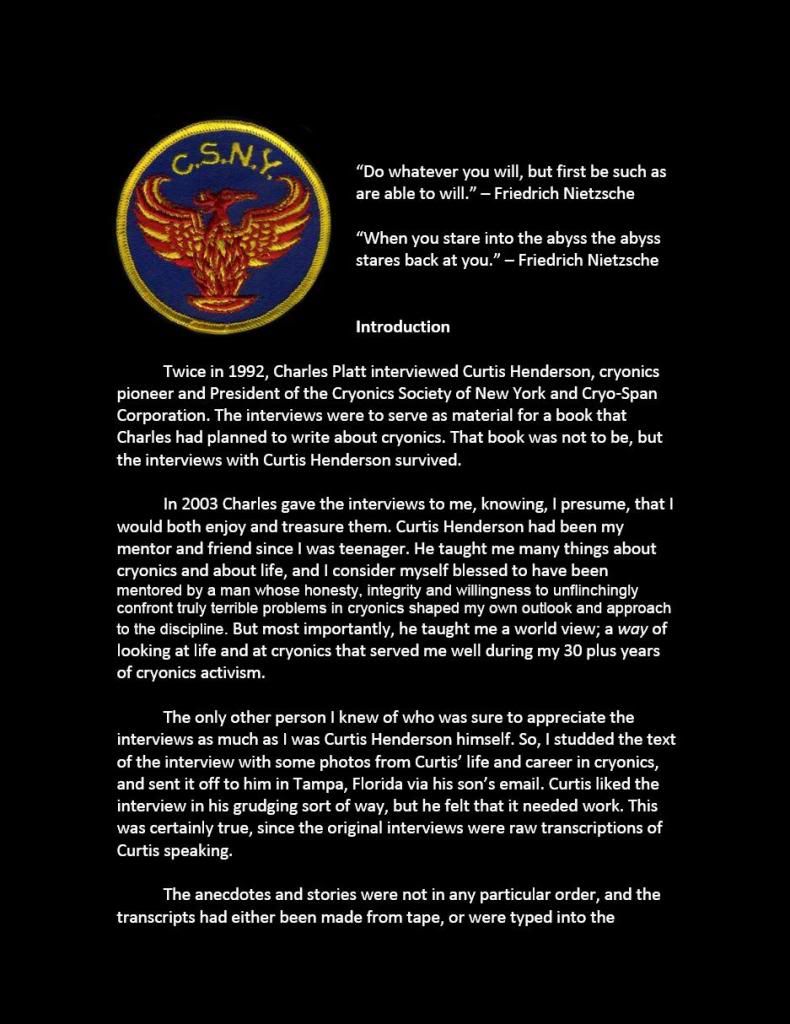
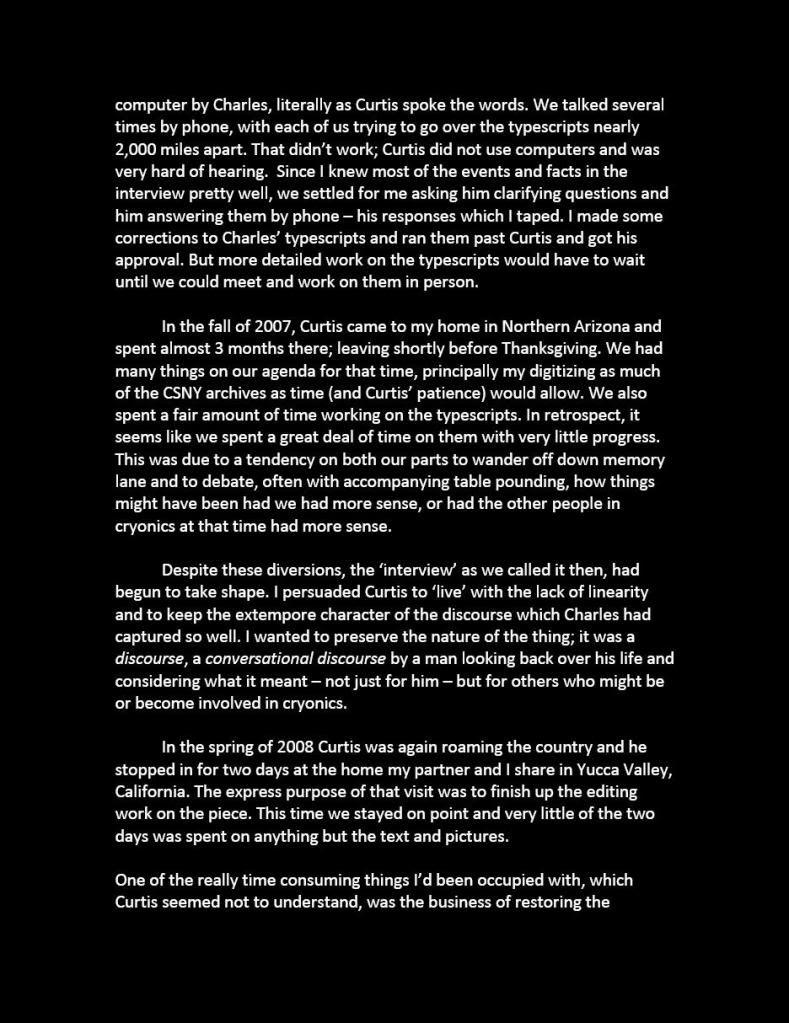
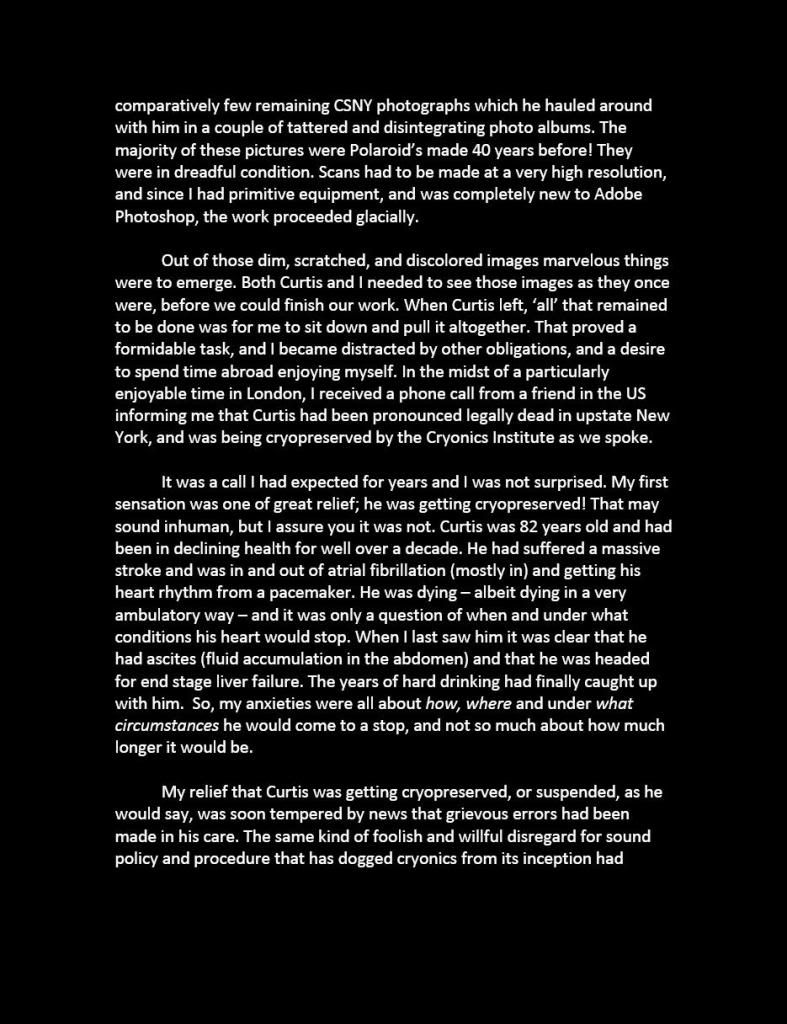
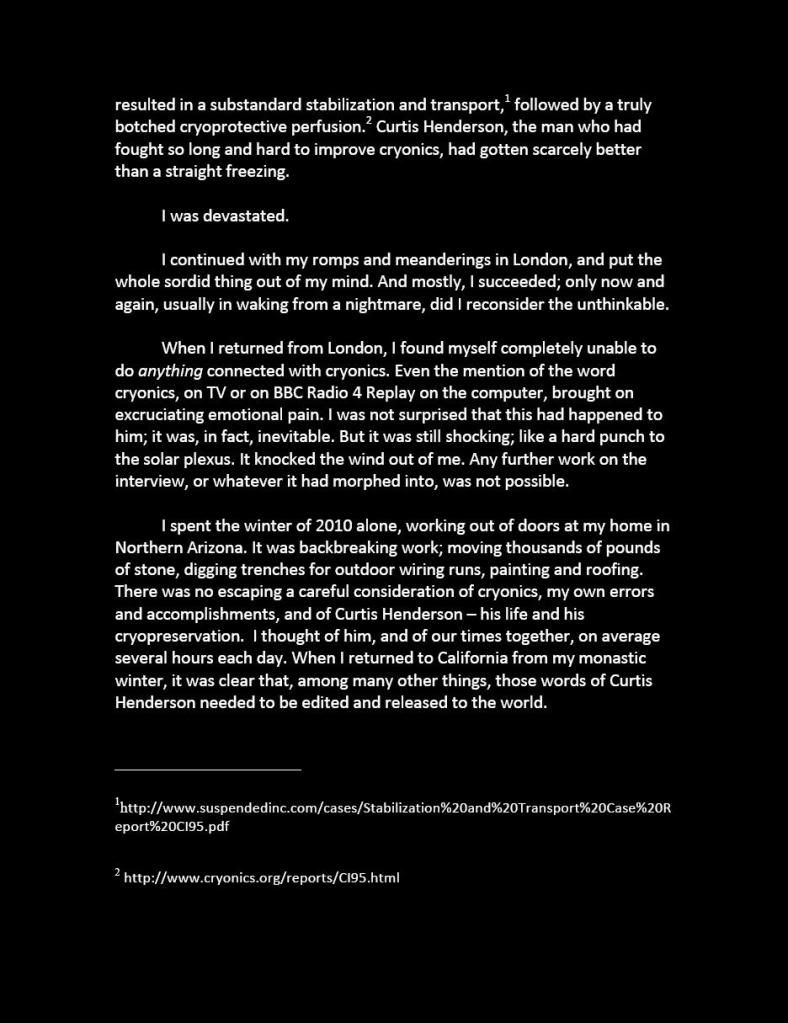
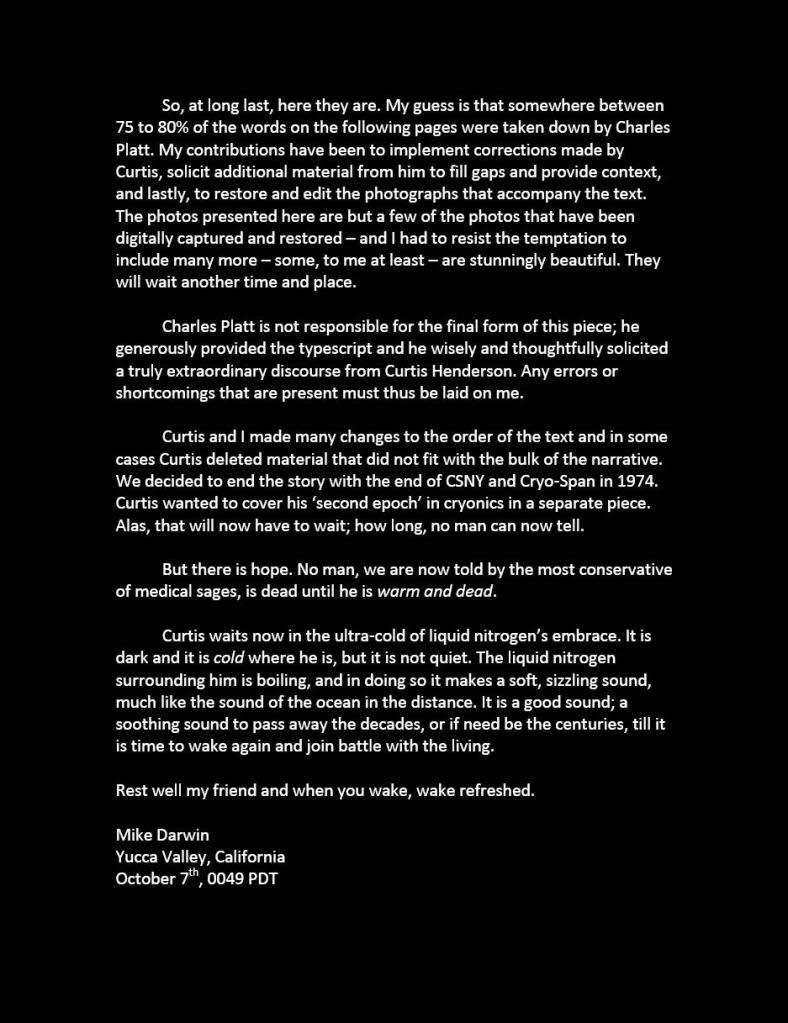
Thus Spake Curtis Henderson, Part I
By Charles Platt and Mike Darwin
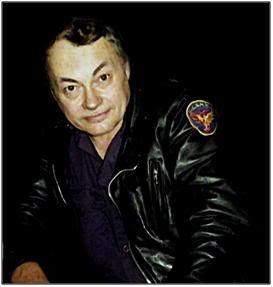
Curtis Henderson, Esq., Winter, 197
For almost thirty years now, Curtis Henderson[1] has been trying to cheat death. Like most people, he doesn’t enjoy the idea of winding up in a mortuary. Unlike most people, he’s spent a large part of his life trying to do something about it. Henderson was one of the founders of the Cryonics Society of New York (CSNY) – a group of activists who decided that since no one else was tackling the challenge of freezing people, they would have to do it themselves.
Back then, in the mid-1960s, Henderson had a job as an insurance adjuster that required him to work only two to three days a week. He also derived income from trust funds passed down from his grandmother, enabling him to buy a house on Long Island, a boat big enough to live on, and a single-engine plane that he kept at a small airport half a mile from his home.[2] He had a beautiful wife and a young son, and the last thing he needed was an obsession that would cause him to give up his job, sell his airplane, break up his marriage, and spend all his money.
Today, in his late sixties, Henderson is a glorious wreck of a man, but he grins and says he wouldn’t have it any other way. He’s still a cryonics activist, still infected by the same bug that bit him almost three decades ago.
As I arrive at his house, on a little dead-end street in a residential backwater, he’s prowling around in his front yard, gathering firewood. He’s an eccentric figure, wearing a dirty old yachting cap, with a pair of glasses dangling from one ear. “Here you see the ruins of numerous failed enterprises,” he says, laughing as he gestures at the relics on his front lawn. There’s a tow-truck, starting to rust, with spare tires heaped against it. Next to it is a small yacht, with its paint flaking off. Further back, a Triumph TR-4 sports car stands amid tall weeds. Behind that, in the rear corner of Henderson’s yard, there’s a rusty steel cylinder – an actual cryonic storage tank, one of the first ever made.[3] It once contained the body of the first person ever frozen, a woman whose name is now lost to history, and who occupied the tank for only a few brief weeks before her son changed his mind and had her conventionally interred.
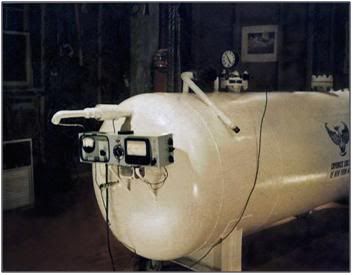
The first cryogenic storage unit designed for human patients, the CC-101, acquired from John Flynn, in Curtis Henderson’s garage in Sayville, L.I., New York, circa 1967.Photo by Curtis Henderson.
In a garage, there’s a 1966 Buick Riviera, on flat tires. Parked behind the house is a VW truck, rusting into oblivion. He drove all over the country in the truck, taking his family with him. When they stopped along the road, his two kids slept inside the tank occasionally, although they used a tent most of the time. Not long after that, his wife, Janet, left him and took the children away to Florida. Henderson eventually won a costly custody battle with his wife and subsequently raised both of his sons on Long Island.

- The Henderson family bomb shelter located behind the family residence at 9 Holmes Court in Sayville, LI. The blast shelter was constructed of concrete reinforced with welded steel railroad track and steel rebar. The walls were 4’ thick on all sides, including the bottom. The surface terminator was a steel reinforced pill box equipped with machine gun mount and military surplus aircraft searchlight. The shelter was constructed by Henderson working alone and without earth moving equipment. The photos above were made by Henderson circa 1969. Photos by Curtis Henderson
I follow him into his house. The kitchen is a disaster area: ceiling tiles have been ripped away, and glass-fiber insulation dangles dangerously. Wooden shelves have been set up on milk crates. A scrawny white cat wanders in, mewing. “That cat,” says Henderson “is thirty years old.[2] My children learned to walk holding onto that cat’s tail.” He thumps the cat with absent-minded affection. “She’s blind, but apart from that, she’s in good health. I’ve been giving her vitamin E. Seems to work pretty well.”
Cryonicists Are Born, Not Made
And so, inevitably, we’re back to the subject of old age and death. Why does Henderson find himself so obsessed with the subject? And how did it all start?
“If you go through the history of cryonics you’ll find everybody who’s into it, they accepted the idea within the first fifteen minutes of hearing it. They said, “This is it!” So, I think it’s genetic. I think we’re dealing with a whole new race here, a whole new species, and as soon as we get rid of all these other people – “He laughs heartily.”
“At some point in childhood, you realize what death is all about. One of my kids saw a dead mole out in the back yard, and he said to me, “Is daddy mole going to fix it?” And I said– (He chuckles and shakes his head.) I gave him a cynical answer.”
“Most people know the average life expectancy, whatever it is, seventy, seventy-five. And they expect to live about that long. At the same time, they know that 150 years from now, they’re not going to be here. So they’re bracketed in there. What they don’t normally consider is that they may die in the next thirty seconds. So they’re not assured of seventy years. And yet, they seem to count on it. Now, people like me, cryonicists, we have a little voice in our heads saying, ‘in my case, there may be an exception.’”

Curtis Henderson's first wife, Janet, circa mid-1990s. Photo by Curtis Henderson.
“When you get to be my age, whenever you pick up a paper you see somebody that’s younger than you dropping dead of a heart attack. In this neighborhood alone, two people back there dropped dead last month. I’m now the oldest one in this whole neighborhood. So, the casualty rate is very high. You’d be surprised how many people die of heart attacks at fifty, or fifty-five. And when you get to be sixty-five, you notice that the balance is beginning to swing. There obituaries are of people younger than you, not older than you.”
“Now, cryonics doesn’t promise you anything in the absolute sense. But nothing promises you anything in the absolute sense. There is no such thing as certainty. A meteor could hit the earth tomorrow, and nobody would even know what happened. Nothing can guarantee that you will live another second, or another 100,000 years. But what cryonics does do is it relieves you of the absolute certainty that you’re going to die. In our hearts, we are immortal, because we have the prospect of immortality, now. We’re doing something, and however slim the possibility may be, the absolute certainty that we won’t be here in another 150 years is gone. So, in a sense, you’re getting the same emotional release that somebody who absolutely believes in one of these religions gets. To me, this is the most important thing about cryonics. And yet most people don’t see it. They just don’t get it. It changes your own perception of yourself more than anything else. It changes your basic relationship with the universe, eternity, everything. It’s like religion, but religion is a passive thing, while cryonics is an active pursuit.”
“For people who are real activists, cryonics becomes almost a reason for existence. I don’t know exactly why that is, but we’ve taken many trips across the country, meeting cryonics people, and it changes everything, because you have a purpose.”
“This probably has a lot to do with my upbringing. I was raised as a person with a cause. My parents were both members of the Communist Party. So emotionally, I was always geared to a cause. One of my brothers is still a Trotskyite, after all these years.”
The Good Life: The Man in the Gray Flannel Suit[5]
 The ERCO Eurcoupe. Image courtesy of Wikipedia Commons.
The ERCO Eurcoupe. Image courtesy of Wikipedia Commons.
“One day in 1964 – I had a very good job, a very cushy job as an insurance adjuster. I had bought this house, I had a big boat, I arranged to do my job in the city in just three days a week, and I had a company car and a company credit card. I had a wife and a son – my second son hadn’t yet been born (when he was, he was named after Robert Ettinger, the father of cryonics). I used to spend most of my time reading, working on my boat, or riding my motorcycle. I saw in The New York Times Book Review, a review of Ettinger’s book.[6] I bought the book, and that was when I heard that little voice telling me, maybe there could be an exception in my case. Reading Ettinger’s book, I thought, was a penance, like reading Das Kapital for the communists. I think it was terribly written. But the idea was what mattered. I wrote to him, and he gave me the names of two other people who had written to him. One was Saul Kent, and the other was a man named Jimmy Sutton. He lived in Queens,[7] and he told me to come and meet him at the Frank Charles bar, under the El (elevated subway), there. This was a typical dingy Queens bar, and this guy was dressed in a pink shirt with big cufflinks.”
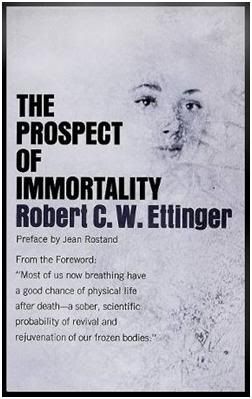
The Prospect of Immortality by Robert C. W. Ettinger, 1964
“Now at that time there was a fellow in Washington D.C., who had started something called the Life Extension Society (LES). He wrote a book previous to Ettinger’s proposing the same kind of thing.[8] But Cooper, Ev Cooper was his name, was even less of a writer than Ettinger; and he lacked the science background that Ettinger had. So, his book never got published.”
“In those days, of course, the assumption was that all we had to do was explain the idea to the powers that be, and obviously Rockefeller, and all these other people who want to live forever, would jump on the bandwagon; and Union Carbide would make the tanks for us. [At that time, there was no such thing as a cryogenic tank big enough to hold a human body.] And all we had to do was tell the world about this wonderful idea.”

E. Francis (Ed) Hope in January of 1967: Hope was a wig salesman and real estate investor who founded Cryo-Care Equipment Corporation in 1966.Photo by Henry Groskinsky.
“Actually, I had a lot of trouble finding Sutton, at first. He didn’t answer my letters. I went to his apartment, just a room in a completely dilapidated, end-of-the-world type of place. A long narrow hallway, one light bulb, one watt, unpaid bills all over the place. I left one of my cards under his door, with a note for him to call me. Finally he called me, and he told me he’d contacted another guy, Saul Kent, who he said was a genius. Saul was in his early twenties. I was already 39 or 40 at the time.”
“I was very spoiled. My grandmother always told me, there’s nothing that will destroy ambition in a man like a small, unearned income, and she was right. I had it made. I had a pretty wife, and two kids, and that boat – I loved that boat it; was a thirty-two foot Richardson. We sailed all over the place.”
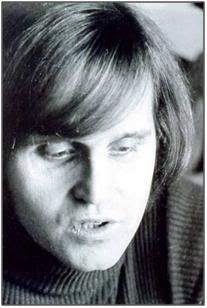
Saul Kent, circa early 1970s
“I met Saul Kent, who was clearly the brains of this thing, and I met Sutton, who was exactly as Saul has described him: He had the least talent and the most ambition of any man he’d ever met. He went on about how he was a businessman, and he was a type who comes to cryonics all too often. Most of them have been eliminated, but they still appear from time to time. ‘Mister Wonderfuls,’ I call them. Sutton would complain about the way Saul dressed. I always had a suit on, because I had to go into the city once a week. I had to change trains at Flushing, so I would walk the two blocks to the Frank Charles bar. So, I always had a suit on and I think, maybe something stupid like that, whether you have a suit on or not, the whole world’s fate hinges on these things. Saul – Saul always wore sandals.”
“That bar was like, I guess, a thousand other bars in Queens: A redneck, blue-collar kind of place with a TV and endless football games running. They served horrible food. Most of the clientele were serious drinkers; they didn’t want to fool around with food. They had a room at the side where there were booths, and that’s where we would meet each week.”
“So, the question was: what were we going to do? Well, for starts, we were all going to be members of this Life Extension Society. We wrote to Ev Cooper and we got back vague letters, in which he would never send us the names and addresses of other people who had written to him. So, we asked if we could print up stationery. He didn’t want us to do that.”
“I had stock in Union Carbide. They were the biggest manufacturer of cryogenic tanks in world. We felt one of the biggest problems was to get a tank that you could store people in. I don’t know why, but we focused on that. So I went to one of their stockholders’ meetings and suggested they should build tanks for us, and of course they looked at me like – well, I got used to that look later on.”
“You understand, all through this, Ettinger would say, ‘Once we freeze the first man, then it’s going to go. That’s when it will really take off.’ But Ettinger didn’t do it. There were opportunities, but he didn’t take them. He lost his nerve. And of course, there were no tanks to put people in.”
END PART I
[1] Curtis Henderson was born on September 28, 1926.
[2] The ERCO Ercoupe is a low wing monoplane first manufactured by the Engineering and Research Corporation (or ERCO) shortly before World War II. It was designed to be the safest fixed-wing aircraft that aerospace engineering could provide at the time, and the type still enjoys a very faithful following today.
[3] This unit was the very first Cryo-Capsule ever made by Cryo-Care Equipment Corporation (CC) of Phoenix, AZ; model CC-101. It was sold by CC to John Flynn who had started a company called Biopreservation. Flynn had Cryocapsule stored in a warehouse in NYC, but he could not pay the rent. Curtis paid off the back-rent and acquired the dewar. MD
[4] The cat’s name was “Crockett,” after Davy Crockett, and he died in his mid-20s – an amazing feat for an outdoor cat. MD
[5] Henderson often likened his life at the time to the one portrayed in the 1956 movie, ‘The Man in the Gray Flannel Suit’ starring Gregory Peck, saying that it was an almost a perfect cinematic rendering of the kind of life he lead. MD
[6] The Prospect of Immortality, by Robert C. W. Ettinger, Doubleday, New York, 1964.
[7] James Sutton lived in Jamaica, Queens, New York. MD
[8] Immortality: Physically, Scientifically, Now by Evan Cooper writing as Nathan Duhring, 20th Century Books Foundation, Washington, D.C., 1962. http://depressedmetabolism.com/pdfs/cooper_immortality.pdf. MD


“For almost thirty years now, Curtis Henderson has been trying to cheat death.”
I wish cryonicists would stop using the phrase “cheating death.” One, it projects the theory of mind to where it doesn’t belong. (Just replace “death” with “god,” for example.) And two, it frames cryonics as an inherently immoral activity. No such anthropomorphism called “death” exists out there for us to “cheat.”
To the best of my knowledge, Charles Platt is not a cryonicist. Charles authored the introduction and, since he was generous enough to provide me with the typescript & intro, I did not feel I could (or should) change it. I should also point out that Charles wrote this in 1992, for a popular book on cryonics to be published from the perspective of a reporter, as I note in my introduction.
Beyond these observations, I agree with you, and I agree with what I presume is your underlying point; namely that words matter – a lot. To get a feel for how deeply (and counter productively) we have been programmed by this diseased culture, it is only necessary to try to start using the correct words and phrases in daily life. That’s surprisingly hard to do – and I’ve been trying for onto 40 years now!